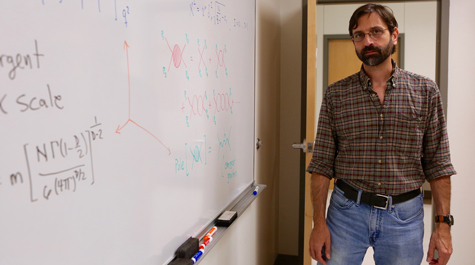Christopher Carone is elected a fellow of the American Physical Society
The Standard Model is the name physicists give to the established inventory of particles and interactions from which the universe is constructed.
“The Standard Model works really, really well for what it covers,” Chris Carone says. It’s been extremely robust over the decades, holding up through a myriad of experimental tests. But as good as it is, the Standard Model is incomplete.
Carone is a professor in William & Mary’s Department of Physics. He was recently elected a 2017 Fellow of the American Physical Society, an honor limited to no more than one half of one percent of the APS membership. Carone becomes the 10th APS Fellow in the W&M physics department, which he currently chairs.
Carone’s APS citation notes his contribution to physics beyond the Standard Model. He explained that “new physics” is necessary to explain the structure of the Standard Model as well as observed phenomena that the Standard Model does not predict.
Physics beyond the Standard Model is the domain of the theorist, but Carone cautions that “theory” doesn’t necessarily mean wild speculation. He explained that much of his work can be tested.
“For the kind of theory that I do, the output can be compared to experimental data,” he said. “If I’m working on some particular mystery in the Standard Model, and the theory I write down has additional particles, I’m particularly interested in pursuing the parts of the theory where those additional particles are within the reach of collider experiments that are running now, or that might be on the horizon.”
New-physics theories deal with such matters as the lightness of the mass of the Higgs boson and why the top quark mass is so different from the mass of the electron. Physics beyond the Standard Model addresses the theoretical existence of both dark matter and dark energy, the term for the cause behind the observed acceleration of the expansion of the universe.
And some interesting new-physics theories also deal with gravity, that most familiar of forces. Gravity has a way of popping up in ways that can be helpful to theorists. Carone explained that two of the biggest mysteries in high-energy physics are dark matter and dark energy.
“Dark energy is known through its gravitational effects on the evolution of the universe, while dark matter is known through its gravitational effects on the rotations of galaxies,” he said. “ Although we’re not certain about the nature of either dark matter or dark energy, we are certain of their existence due to their gravitational interactions."
Carone has worked on dark matter theories; he explained that dark matter is a theoretical answer to a gravitational conundrum posed by observation of rotations within galaxies.
"Matter rotating about galaxies is moving too fast to be held in place by the gravitational pull of visible stars,” he said. “So you infer from galactic rotation curves that there must be more stuff there than you're seeing.”
Physicists have ruled out chunks of space debris, non-luminous planets and other possible reasons for why galaxies rotate more quickly than expected, and for some time, Carone and other theorists have decided that a new elementary dark-matter particle is the most plausible explanation.
“There’s some particle that has to be added to the Standard Model,” he said. A dark-matter particle would have to couple very weakly to electromagnetic radiation, which includes visible light, to explain why you can't see it.
“But everything couples to gravity,” Carone added. “So if you have this extra particle — dark matter — around, then you could potentially explain the type of matter that you’re not seeing, but that’s affecting the galactic rotation curve.”
There are a number of theoretical descriptions of the dark matter particle and each physicist hopes his or her own mathematical profile of the thing will match the actual observation.
Carone said the verification of the dark matter particle —if it comes—will almost certainly come from an experiment like those being conducted at the Large Hadron Collider or any number of other facilities. He explained that the search for new particles requires the theorist and the experimenter to work together.
“When you start colliding and producing lots of particles, finding a signal is like looking for a needle in a haystack,” Carone said. “To find new physics, you need to understand the signal and potential backgrounds extremely well. Theorists provide important guidance to experimenters in this process.”
Exotic particles produced in a collider have an almost unimaginably short life, and each particle has its own detector signature. Carone explained that it’s necessary for theorists and experimenters to discuss the most promising search strategies for identifying features of the data that may be the signature of a new particle, and that are the most easy to distinguish from statistical fluctuations. "And you expect statistical fluctuations," he said.
“If that’s the case, then you just wait longer,” he said. “As the experimenter accumulates more data, then you might find that a discrepancy with a prediction of the standard model decreases in statistical significance over time.”
The Higgs boson’s discovery in 2012 filled the last unverified niche in the Standard Model, and observational verification of physics beyond the Standard Model has been elusive.
And a thorough understanding of gravity, Carone says, would be an enormous help.
“Of all the forces of nature, we have quantum theories that describe all of them. But the only one we’re not certain of is gravity,” he said. “If we were certain about what the quantum theory of gravity was, we would get some insight about a lot of other questions.”














